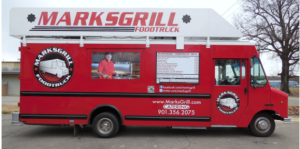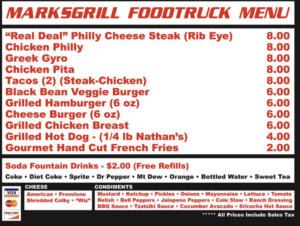Lépjen offline állapotba az Player FM alkalmazással!
Serve Faster, Sell More: Speed Tips for Food Truck Owners
Manage episode 439168302 series 1539985
In this exclusive interview, Mark Hamilton breaks down the key to running a profitable food truck: speed. “Serving food faster isn’t just about efficiency—it’s about making more money and keeping customers happy,” says Hamilton. He knows firsthand that the faster you can get food in customers’ hands, the more orders you can serve, and the more likely they’ll come back. Hamilton also shares his “more the merrier” philosophy for avoiding customer burnout, explaining that parking alongside other trucks can help draw bigger crowds and keep things fresh.
If you’re looking for ways to increase your revenue, improve your workflow, and keep lines moving, Hamilton’s got you covered with specific, actionable tips to serve food faster and grow your food truck business.

The guys that are making money are doing it very fast. The people that aren’t are very slow. – Mark Hamilton on food truck operations.
Mark Hamilton knows that in the world of food trucks, speed is more than just a competitive edge—it’s survival. “Serving food faster isn’t just about efficiency—it’s about making more money and keeping customers happy,” he says. And he’s right. In a business where customers expect fast meals, slow service can quickly put you out of business.
The math is simple. Every extra minute someone waits in line is another potential customer who walks away. If you’re slow, you’re not just losing one sale—you’re losing dozens of sales every week. Mark learned this lesson the hard way.
Early on, he saw how bottlenecks in his kitchen or hesitation at the order window cut into profits. He refined his operation, streamlining processes and simplifying his menu until his team could serve at lightning speed. Hamilton’s point is clear: speed is key to long-term success in the food business.
Ways Cut Service Times and Increase Profit on a Food Truck
Build a Team: Mark Hamilton doesn’t leave anything to chance when it comes to speed. His truck, Mark’s Grill, runs like a well-oiled machine, and that’s thanks to a tight-knit, four-person team he’s trained to deliver fast service without sacrificing quality. The secret? Every team member has a specific role, and each of them is trained to master it with precision.
Hamilton starts by breaking down the truck’s operation into simple, repeatable tasks. “Everyone knows exactly what they’re responsible for, and they stick to it,” he explains. One person handles the grill, another the prep station, a third person manages the finishing and plating, and the fourth takes orders and runs customer service. This way, no one’s stepping on each other’s toes, and the line keeps moving.
His training process is hands-on and detail-oriented. Every new team member spends time with Hamilton learning not just how to cook, but how to cook efficiently. They practice prepping ingredients, assembling dishes, and moving through the small space quickly. “It’s all about muscle memory,” Hamilton says. Repetition creates speed, and speed creates more orders. There’s no room for hesitation, so Hamilton drills his team until the process feels natural.

Mark’s Grill keeps things simple so they can serve customers faster.
Food Truck Kitchen Design: The kitchen of Mark’s Grill was designed with one thing in mind: speed. Every inch of space serves a purpose, and there’s no room for wasted motion. “It’s tight, but everything’s within arm’s reach,” Mark Hamilton says. From the placement of the grill to the prep station, it’s all laid out to keep his team moving efficiently.
Hamilton studied fast food giants like McDonald’s, mimicking their use of vertical space and streamlined workflows. Ingredients are prepped and stored within easy reach, with sauces, toppings, and buns all organized for quick grabs. The grill’s positioned right next to the assembly line, so food moves from cook to prep in a matter of seconds. “It’s intense,” Hamilton admits, but the setup keeps the team working fast, allowing them to churn out more orders in less time without missing a beat.

Mark suggests never parking alone as a food truck.
Efficient Packaging: Mark Hamilton understands that packaging can make or break a food truck’s speed. “It has to be simple, sturdy, and fast to use,” he says. His packaging is designed for efficiency—no complex folds, no extra steps. Burgers go into easy-to-close clamshells, fries into durable paper bags, and everything fits snugly together, minimizing time spent fiddling with lids or wrapping.
Hamilton avoids containers that require extra assembly or double-bagging, opting for materials that can handle heat and grease without compromising speed. “The goal is to get it packed and out the window in under 30 seconds,” he explains. Even the placement of packaging is intentional—stored within arm’s reach of the team, so there’s no time lost searching for the right size or item. With everything streamlined, Hamilton’s team can focus on getting food to customers fast, without sacrificing quality or presentation.
Keep the Menu Simple: Keeping a simple menu is central to Mark Hamilton’s approach, and it’s not just about limiting choices—it’s about making everything easier to serve. “The fewer items you have, the faster you can prep and cook,” he explains. By focusing on a handful of core dishes, Hamilton’s team can master them, ensuring consistent quality and quick turnaround.
Each menu item is built around ingredients that can be prepped in bulk and used across several dishes. “It cuts down on both time and confusion in the kitchen,” says Hamilton. With fewer ingredients to juggle, there’s less risk of mistakes or delays. This simplicity also means his team doesn’t get bogged down by complex orders, and the streamlined process lets them serve more customers in less time.
What You’ll Learn
- How Hamilton worked with his city council in Memphis to negotiate and help educate local government about food trucks.
- Why Hamilton decided to create his own vehicle, purchased a Morgan Olson 18 foot cargo step van, gutted it, and put in a complete restaurant kitchen.
- Learn how the kitchen of Mark’s Grill was designed for speed and efficiency. It’s pretty intense.
- How Hamilton built a workflow for taking orders, gathering items, and getting product out the window as quickly as possible.
- Why the speed at which you can serve customers can literally make or break a food business.
- How to identify a food niche in your area.
- How Hamilton trains a team of four people to operate the truck.
- Why you should invest a lot of time considering the layout of your mobile kitchen.
- The importance of having multiple locations to park.
- Why you should always work in teams of food trucks and never park alone.
Mentioned in the Episode
Mark’s Grill – This is the official website of Mark’s Grill. Check out the menu and find out where in Memphis the truck will be located next.
Morgan Olson – This is the brand of van that Hamilton purchased for his business.
Shelby Farms – A major park in the city of Memphis where you can often find Mark’s Grill.
The Food Truck Owners Guide to Dealing with Bad Reviews – This is the post I put together to help you manage the listings people see when they type the name of your food business into Google and other search engines. I explain this in more detail on the show.
The post Serve Faster, Sell More: Speed Tips for Food Truck Owners appeared first on Food Truck Empire.
14 epizódok
Manage episode 439168302 series 1539985
In this exclusive interview, Mark Hamilton breaks down the key to running a profitable food truck: speed. “Serving food faster isn’t just about efficiency—it’s about making more money and keeping customers happy,” says Hamilton. He knows firsthand that the faster you can get food in customers’ hands, the more orders you can serve, and the more likely they’ll come back. Hamilton also shares his “more the merrier” philosophy for avoiding customer burnout, explaining that parking alongside other trucks can help draw bigger crowds and keep things fresh.
If you’re looking for ways to increase your revenue, improve your workflow, and keep lines moving, Hamilton’s got you covered with specific, actionable tips to serve food faster and grow your food truck business.

The guys that are making money are doing it very fast. The people that aren’t are very slow. – Mark Hamilton on food truck operations.
Mark Hamilton knows that in the world of food trucks, speed is more than just a competitive edge—it’s survival. “Serving food faster isn’t just about efficiency—it’s about making more money and keeping customers happy,” he says. And he’s right. In a business where customers expect fast meals, slow service can quickly put you out of business.
The math is simple. Every extra minute someone waits in line is another potential customer who walks away. If you’re slow, you’re not just losing one sale—you’re losing dozens of sales every week. Mark learned this lesson the hard way.
Early on, he saw how bottlenecks in his kitchen or hesitation at the order window cut into profits. He refined his operation, streamlining processes and simplifying his menu until his team could serve at lightning speed. Hamilton’s point is clear: speed is key to long-term success in the food business.
Ways Cut Service Times and Increase Profit on a Food Truck
Build a Team: Mark Hamilton doesn’t leave anything to chance when it comes to speed. His truck, Mark’s Grill, runs like a well-oiled machine, and that’s thanks to a tight-knit, four-person team he’s trained to deliver fast service without sacrificing quality. The secret? Every team member has a specific role, and each of them is trained to master it with precision.
Hamilton starts by breaking down the truck’s operation into simple, repeatable tasks. “Everyone knows exactly what they’re responsible for, and they stick to it,” he explains. One person handles the grill, another the prep station, a third person manages the finishing and plating, and the fourth takes orders and runs customer service. This way, no one’s stepping on each other’s toes, and the line keeps moving.
His training process is hands-on and detail-oriented. Every new team member spends time with Hamilton learning not just how to cook, but how to cook efficiently. They practice prepping ingredients, assembling dishes, and moving through the small space quickly. “It’s all about muscle memory,” Hamilton says. Repetition creates speed, and speed creates more orders. There’s no room for hesitation, so Hamilton drills his team until the process feels natural.

Mark’s Grill keeps things simple so they can serve customers faster.
Food Truck Kitchen Design: The kitchen of Mark’s Grill was designed with one thing in mind: speed. Every inch of space serves a purpose, and there’s no room for wasted motion. “It’s tight, but everything’s within arm’s reach,” Mark Hamilton says. From the placement of the grill to the prep station, it’s all laid out to keep his team moving efficiently.
Hamilton studied fast food giants like McDonald’s, mimicking their use of vertical space and streamlined workflows. Ingredients are prepped and stored within easy reach, with sauces, toppings, and buns all organized for quick grabs. The grill’s positioned right next to the assembly line, so food moves from cook to prep in a matter of seconds. “It’s intense,” Hamilton admits, but the setup keeps the team working fast, allowing them to churn out more orders in less time without missing a beat.

Mark suggests never parking alone as a food truck.
Efficient Packaging: Mark Hamilton understands that packaging can make or break a food truck’s speed. “It has to be simple, sturdy, and fast to use,” he says. His packaging is designed for efficiency—no complex folds, no extra steps. Burgers go into easy-to-close clamshells, fries into durable paper bags, and everything fits snugly together, minimizing time spent fiddling with lids or wrapping.
Hamilton avoids containers that require extra assembly or double-bagging, opting for materials that can handle heat and grease without compromising speed. “The goal is to get it packed and out the window in under 30 seconds,” he explains. Even the placement of packaging is intentional—stored within arm’s reach of the team, so there’s no time lost searching for the right size or item. With everything streamlined, Hamilton’s team can focus on getting food to customers fast, without sacrificing quality or presentation.
Keep the Menu Simple: Keeping a simple menu is central to Mark Hamilton’s approach, and it’s not just about limiting choices—it’s about making everything easier to serve. “The fewer items you have, the faster you can prep and cook,” he explains. By focusing on a handful of core dishes, Hamilton’s team can master them, ensuring consistent quality and quick turnaround.
Each menu item is built around ingredients that can be prepped in bulk and used across several dishes. “It cuts down on both time and confusion in the kitchen,” says Hamilton. With fewer ingredients to juggle, there’s less risk of mistakes or delays. This simplicity also means his team doesn’t get bogged down by complex orders, and the streamlined process lets them serve more customers in less time.
What You’ll Learn
- How Hamilton worked with his city council in Memphis to negotiate and help educate local government about food trucks.
- Why Hamilton decided to create his own vehicle, purchased a Morgan Olson 18 foot cargo step van, gutted it, and put in a complete restaurant kitchen.
- Learn how the kitchen of Mark’s Grill was designed for speed and efficiency. It’s pretty intense.
- How Hamilton built a workflow for taking orders, gathering items, and getting product out the window as quickly as possible.
- Why the speed at which you can serve customers can literally make or break a food business.
- How to identify a food niche in your area.
- How Hamilton trains a team of four people to operate the truck.
- Why you should invest a lot of time considering the layout of your mobile kitchen.
- The importance of having multiple locations to park.
- Why you should always work in teams of food trucks and never park alone.
Mentioned in the Episode
Mark’s Grill – This is the official website of Mark’s Grill. Check out the menu and find out where in Memphis the truck will be located next.
Morgan Olson – This is the brand of van that Hamilton purchased for his business.
Shelby Farms – A major park in the city of Memphis where you can often find Mark’s Grill.
The Food Truck Owners Guide to Dealing with Bad Reviews – This is the post I put together to help you manage the listings people see when they type the name of your food business into Google and other search engines. I explain this in more detail on the show.
The post Serve Faster, Sell More: Speed Tips for Food Truck Owners appeared first on Food Truck Empire.
14 epizódok
Minden epizód
×Üdvözlünk a Player FM-nél!
A Player FM lejátszó az internetet böngészi a kiváló minőségű podcastok után, hogy ön élvezhesse azokat. Ez a legjobb podcast-alkalmazás, Androidon, iPhone-on és a weben is működik. Jelentkezzen be az feliratkozások szinkronizálásához az eszközök között.




